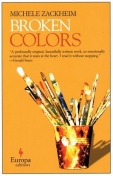BKMT READING GUIDES
Broken Colors
by Michele Zackheim
Paperback : 288 pages
0 club reading this now
0 members have read this book
Sophie Marks' path to artistic and personal fulfillment takes her from World War II England to postwar Paris and the Italian countryside. She ...
Introduction
"A profoundly original, beautifully written work, so emotionally accurate that it tears at the heart. I read it without stopping."-Gerald Stern
Sophie Marks' path to artistic and personal fulfillment takes her from World War II England to postwar Paris and the Italian countryside. She leaves Europe in 1967 and spends the next two decades in the American Southwest. Acclaimed at last as an artist, she returns to England to confront the hidden memories of her childhood and test the possibilities of a renewed love, a passion ripened by maturity.
Excerpt
Sophie was painting again. She needed to hone her skills; like a musician, like any artist, she needed to practice. She was easing her grandfather’s style out of her technique of painting — his colors, his dark lines, his people’s faces imbued with their rural lives – all giving way to her own style. Her colors were becoming muted, the edges gentler, as if her hand was moving in slow motion; she was reminded of the blurred photograph of her father. ...Discussion Questions
1. Broken Colors is a novel punctuated by a speckling of quotes from famous authors and writers. Do the quotes help develop the theme of the novel?2. What is the correlation between travel and age in this novel? Does Sophie’s constant relocating match her shifting emotional landscape, and are the two inextricably tied? Is Sophie in Paris different then Sophie in the American Southwest?
3. If Sophie’s grandfather hadn’t taught her to paint, would she have turned to art as a necessary form of expression?
4. Early in the novel, Sophie meets a fellow painter, Major Roderick, whose face is
grotesquely disfigured with partial vision. What is the significance of this character at that point in Sophie’s journey?
5. What was your reaction when Sophie first met Luca? Is it important that they’re both artists?
6. How do you feel about setting art against the backdrop of war and loss? Does it make art feel like a more vital human resource?
7. On page 230, Sophie explains what the term ‘broken colors’ means? Do you think the book is aptly titled? Is this a strong metaphor for Sophie’s life?
8. As a reader, were you rooting for the character of Luca to return to Sophie’s life? Were you surprised by his re-introduction in the latter part of the novel?
Notes From the Author to the Bookclub
Q: What sparked the decision to make the change from visual artist to writer? A: Over the years, I used words more and more in my paintings . . . until I finally wrote myself off the canvas. Q: What is the difference in preparing to write non-fiction (Einstein’s Daughter) and fiction (Broken Colors)? A: There is not a big difference in the preparation because I do so much research for both genres. However, in fiction I can embroider as much as I like and in non-fiction I have to tell the absolute truth . . . and that is not so much fun. Q: How much of Sophie Marks is Michele Zackheim? A: That’s a secret. Q: How does research play a part in your writing process? What were some of your source materials for Broken Colors? A: I metaphorically lay all the pieces of my research down on a table and create a collage. Some of the books I used as source material are: The Artist’s Handbook by Ralph Meyers; Women, Art and Society by Whitney Chadwick; the catalogue for the exhibition at the National Portrait Gallery in London, Self Portrait: Renaissance to Contemporary; Originals: American Women Artists by Eleanor Munro; Poets on Painters edited by J.D. McClatchy; and Birthday by Dorothea Tanning. Q: From being on the road as an artist with the installation, The Tent of The Meeting, to scouring Serbia looking for clues for Einstein’s Daughter, to the fictitious cross continental journey of Sophie Marks-travel is a constant fixture in your work. Is your work dictated by travel, or is travel dictated by your work? A: Both. I do occasional “walk-abouts” where I purposely travel to new and sometimes difficult places. Ideas can come from those adventures, of course. But I also deliberately travel to the places that I want to write about. Q: Did you find yourself painting while writing Broken Colors? Did you try to paint from Sophie’s perspective as a part of realizing the character? A: No, I did not paint or draw while writing the book. I used my imagination to develop Sophie’s style. Q: What are you reading currently? A: I’m reading three books. Last Train from Berlin by Howard K. Smith, Berlin Diary by William Shirer, and Roughing It by Mark Twain.Book Club Recommendations
Recommended to book clubs by 0 of 0 members.
Book Club HQ to over 90,000+ book clubs and ready to welcome yours.
Get free weekly updates on top club picks, book giveaways, author events and more








